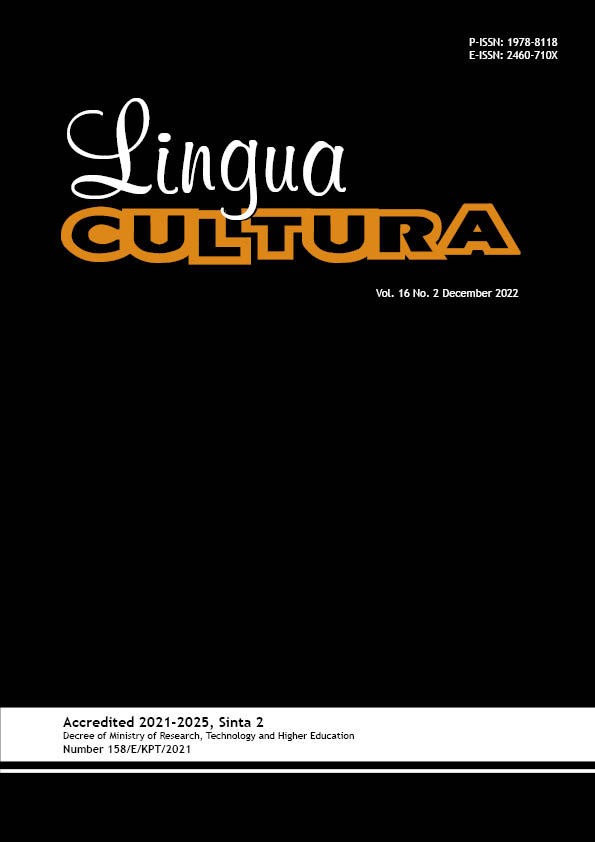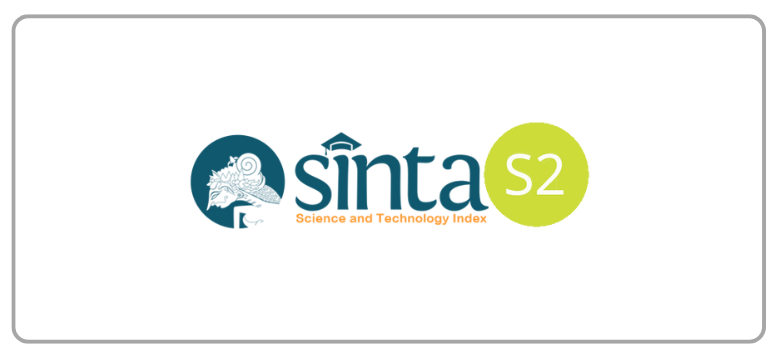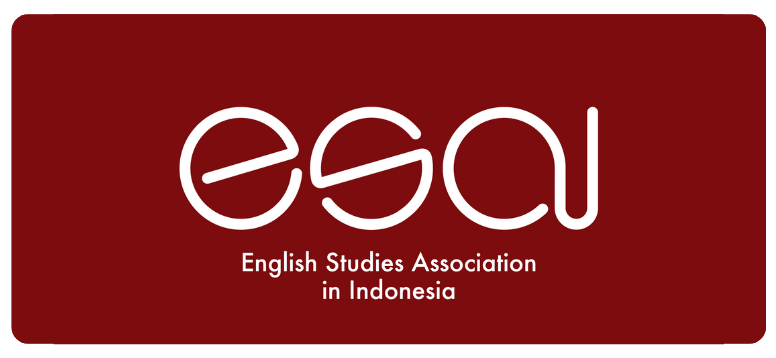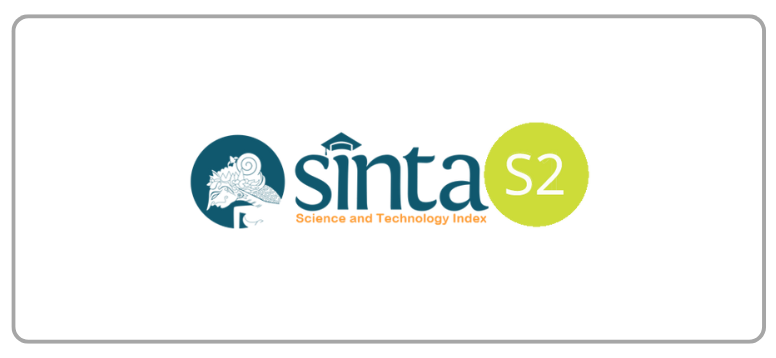Discovering the Prosodic Domain of Aceh Hakka Tone Sandhi
DOI:
https://doi.org/10.21512/lc.v16i2.8595Keywords:
Aceh Hakka, tonal inventory, tone sandhi, prosodic domain, c-commandAbstract
The research investigated the tonal system of the Hakka dialect spoken in the Aceh province of Indonesia. The aim of the research was twofold. First, it retranscribed the dialect’s tonal inventory and provided a comparison with Meixian Hakka and the inventory found in Chen’s (2007) research. Second, it analyzed the Shang Tone Sandhi Rule (STSR) of the dialect and its prosodic domain. The data were collected with a careful design based on the number of syllables, different prosodic structures, and a variety of tonal combinations. The data were collected from two informants, who were female Hakka native speakers that originated from Banda Aceh, Indonesia. The research used mainly an impressionistic approach with some support from Praat Version 6.2.14 to evaluate the pitch of the tones. As for the research’s transcription, the researchers opt for the simpler yet phonologically distinct three-level height system (H, M, L) rather than the five-pitch category of Chao. The research identifies that there are six tonal values in this dialect. The tonal alternation rule, i.e., STSR, operates in a multisyllabic domain, and only the tone at the end of a domain is intact from tonal alternation. The STSR is not sensitive to the syntactic domain c-command relation of the Direct Reference Hypothesis. It also behaves differently compared to the Guangxing dialect Yangping Tone Sandhi Rule. As for prosody, the hierarchical domain of the rule in Aceh Hakka is bounded within the Utterance (U), which is different from the Yinping tone sandhi domain in Meinong Hakka, in which tone sandhi is blocked by the I domain (intonational phrase domain). Therefore, the researchers postulate that the domain for Aceh Hakka Shang tone sandhi lies in the Utterance (U).
References
Azeharie, S., Sari, W. P., & Tjhin, K. (2017). Cultural adaptation of Acehnese and ethnic Chinese in Banda Aceh, from intercultural communication perspective. International Journal of Communication and Media Studies (IJCMS), 7(4), 61-68.
Boersma, P., & Weenink, D. (2022). Praat: Doing phonetics by computer (Computer program) (6.2.14.). Retrieved June 25th 2022 from http://www.praat.org/.
Chai, Y., & Ye, S. (2022). Checked syllables, checked tones, and tone sandhi in Xiapu Min. Languages, 7(1), 47-74. https://doi.org/10.3390/LANGUAGES7010047.
Chang, H. P., Chang, C. C., & Chang, W. A. (2021). Hakka migrant hometown associations: Development and social network patterns: Asian and Pacific Migration Journal, 30(3), 386-399. https://doi.org/10.1177/01171968211046395.
Chao, Y. R. (1930). A system of tone-letters. Le Maître Phonétique, 8, 24-47.
Chen, J. (2018). Sequential and tonal markedness in Zijin Hakka Tone Sandhi (pp. 428-443). China: Atlantis Press. https://doi.org/10.2991/HSSMEE-18.2018.73.
Chen, M. Y. (2000). Tone Sandhi. Cambridge: Cambridge University Press. https://doi.org/10.1017/CBO9780511486364.
Chen, X. H. (2007). Yinni yaqi Kejia ren zhi yanjiu (The study of Hakka people in Aceh, Indonesia). Master Thesis. Taipe: National Chengchi University.
Cheung, Y. M. (2011). Vowels and tones in Mei Xian Hakka: An acoustic and perceptual study. Doctoral dissertation. Hongkong: City University of Hong Kong. Retrieved June 25th 2022 from http://lbms03.cityu.edu.hk/theses/c_ftt/phd-ctl-b40860632f.pdf.
Chung, R. F. (1989). Aspects of Kejia phonology. Doctoral dissertation. Illinois: University of Illinois at Urbana-Champaign.
Hashimoto, M. J. (1973). The Hakka dialect: A linguistic study of its phonology, syntax, and lexicon. Cambridge: Cambridge University Press.
Hsiao, Y. E. (2017). Intonational phrasing in Zhuolan Raoping. In L. Zhang (Ed.), Proceedings of the 29th North American Conference on Chinese Linguistics (NACCL-29) (Vol. 1, pp. 114-124). University of Memphis.
Huang, X. Z. (1992). Meixian kejiahua de yuyin tedian (The Phonetic features of Meixian Hakka). Fangyan(Dialect), 4, 275-289.
Kaisse, E. M. (1985). Connected speech: The interaction of syntax and phonology. Cambridge: Academic Press.
Lau, C. F. (2016). Hakka dialect. In S. Chan, J. Minett, & F. L. W. Yee (Eds.), The Routledge Encyclopedia of the Chinese Language. UK: Routledge Handbooks Online. https://doi.org/10.4324/9781315675541.CH27.
Lee, J. (2016). Alternations and preservations in Tone Sandhi of Meixian Hakka. Concentric: Studies in Linguistics, 42(2), 41-63. https://doi.org/10.6241/concentric.ling.42.2.02.
Liao, C. I. (2020). Family language policy in a Hakka community in Sabah, Malaysia. Journal of Modern Languages, 30(1), 122-141. https://doi.org/10.22452/JML.VOL30NO1.4.
Lin, Y. H. (2007). The sounds of Chinese. Cambridge: Cambridge University Press.
Ministry of Education, R. O. C. Dictionary of frequently-used Taiwan Hakka. Retrieved June 25, 2022 from https://hakkadict.moe.edu.tw/cgi-bin/gs32/gsweb.cgi/login?o=dwebmge&cache=1652374351565.
Nasution, V. A., & Ayuningtyas, N. (2020). The language choice of Chinese community in Medan: A sociolinguistics study. JOALL (Journal of Applied Linguistics and Literature), 5(1), 11-25. https://doi.org/10.33369/JOALL.V5I1.9063.
Nespor, M., & Vogel, I. (1986). Prosodic phonology. New York: Foris Publications.
Norman, J. (1988). Chinese. Cambridge: Cambridge University Press.
Ong, T. W. S. (2020). Contemporary Hakka language maintenance in multilingual Penang, Malaysia. Revista Linguagem & Ensino, 23(4), 1349-1369. https://doi.org/10.15210/RLE.V23I4.17267.
Selkirk, E. (1986). On derived domains in sentence phonology. Phonology, 3, 371-405. https://doi.org/10.1017/S0952675700000695.
Srimulyani, E., Afriko, M., Salim, M. A., & Ichwan, M. N. (2018). Diasporic Chinese community in post-conflict Aceh: Socio-cultural identities, and social relations with Acehnese Muslim majority. Al-Jami’ah: Journal of Islamic Studies, 56(2), 395-420. https://doi.org/10.14421/AJIS.2018.562.395-420.
Tung, C. M. (2010). Yinping Tone Sandhi in Meinong Hakka: An OT analysis. (Master’s thesis). Taipe: National Chengchi University. Retrieved June 25th 2022 from http://thesis.lib.nccu.edu.tw/record/#G0097555013
Ungsitipoonporn, S. (2020). Transmission of Hakka traditional knowledge from two revitalization projects in Thailand: What did they achieve? Dialectologia, 24, 253-272. https://doi.org/10.1344/DIALECTOLOGIA2019.24.11.
Wang, L. J. (2018). Toward transnational identity? The reconstruction of Hakka identity in Thailand. Asian Ethnicity, 19(2), 211-234. https://doi.org/10.1080/14631369.2017.1340091.
Wang, X. (2017). Family language policy by Hakkas in Balik Pulau, Penang. International Journal of the Sociology of Language, 2017(244), 87-118. https://doi.org/10.1515/IJSL-2016-0058/MACHINEREADABLECITATION/RIS.
Wulandari, M. (2018). The communicative accommodation of Chinese in Singkawang. In Proceedings of the Tenth Conference on Applied Linguistics and the Second English Language Teaching and Technology Conference in collaboration with the First International Conference on Language, Literature, Culture, and Education. Bandung, Indonesia. pp. 618-621. https://doi.org/10.5220/0007172006180621.
Xie, Y. (1994). Meixian kejia fang yan zhi. Guangzhou: Jinan University Press.
Yip, M. (2002). Tone. Cambridge: Cambridge University Press.
Yuan, J. H., Shi, A. S, Zhan, B. H., & Wang, F. T. (2001). Outline of Chinese Dialects (Hanyu fangyan gaiyao). Beijing: Yuwen Chubanshe.
Zhang, J. (2019). Speakers treat transparent and opaque alternation patterns differently - Evidence from Chinese Tone Sandhi. In R. Stockwell, M. O`Leary, Z. Xu., & Z. L. Zhou (Eds.), Proceedings of the 36th West Coast Conference on Formal Linguistics (WCCFL). pp. 22-40.
Zhang, Q. (2021). The syllabification, de-syllabification, and vocalisation of nasals in Gannan Hakka dialects. Bulletin of Chinese Linguistics, 14(2), 251-264. https://doi.org/10.1163/2405478X-01402010.
Downloads
Published
How to Cite
Issue
Section
License
Copyright (c) 2022 Johnny Lee, Wang-Chen Ling

This work is licensed under a Creative Commons Attribution-ShareAlike 4.0 International License.
Authors who publish with this journal agree to the following terms:
a. Authors retain copyright and grant the journal right of first publication with the work simultaneously licensed under a Creative Commons Attribution License - Share Alike that allows others to share the work with an acknowledgment of the work's authorship and initial publication in this journal.
b. Authors are able to enter into separate, additional contractual arrangements for the non-exclusive distribution of the journal's published version of the work (e.g., post it to an institutional repository or publish it in a book), with an acknowledgment of its initial publication in this journal.
c. Authors are permitted and encouraged to post their work online (e.g., in institutional repositories or on their website) prior to and during the submission process, as it can lead to productive exchanges, as well as earlier and greater citation of published work.
USER RIGHTS
All articles published Open Access will be immediately and permanently free for everyone to read and download. We are continuously working with our author communities to select the best choice of license options, currently being defined for this journal as follows: Creative Commons Attribution-Share Alike (CC BY-SA)


















